Effect of Planting Date on Accumulated Temperature and Maize Growth under Mulched Drip Irrigation in a Middle-Latitude Area with Frequent Chilling Injury
Abstract
:1. Introduction
2. Materials and Methods
2.1. Site Description
2.2. Field Experiment
2.3. Observation Indexes and Methods
3. Results
3.1. Effects of Planting Date and Film Mulching on Heat Distribution
3.1.1. Soil Temperature
3.1.2. Active Accumulated Temperature
3.2. Effect of Planting Date on Maize Growth Process
3.3. Effects of Planting Date on Maize Growth Indexes
3.4. Effects of Planting Date on Maize Yield Indexes
4. Discussion
5. Conclusions
Acknowledgments
Author Contributions
Conflicts of Interest
References
- Parry, M.; Canzaiani, O.; Palutikof, J.; van der Linden, P.J.; Hanson, C. Climate change 2007: Impacts, adaptation and vulnerability. J. Environ. Qual. 2007, 37, 2407. [Google Scholar]
- Kucharik, C. A multidecadal trend of earlier corn planting in the central USA. Agron. J. 2006, 98, 1544–1550. [Google Scholar] [CrossRef]
- Olesen, J.E.; Trnka, M.; Kersebaum, K.C.; Skjelvåg, A.O.; Seguin, B.; Peltonensainio, P.; Micale, F. Impacts and adaptation of european crop production systems to climate change. Eur. J. Agron. 2001, 34, 96–112. [Google Scholar] [CrossRef]
- Zhao, J.; Yang, X.; Dai, S.; Lv, S.; Wang, J. Increased utilization of lengthening growing season and warming temperatures by adjusting sowing dates and cultivar selection for spring maize in northeast China. Eur. J. Agron. 2015, 67, 12–19. [Google Scholar] [CrossRef]
- Horai, K.; Ishii, A.; Mae, T.; Shimono, H. Effects of early planting on growth and yield of rice cultivars under a cool climate. Field Crops Res. 2013, 144, 11–18. [Google Scholar] [CrossRef]
- Sacks, W.J.; Kucharik, C.J. Crop management and phenology trends in the U.S. Corn Belt: Impacts on yields, evapotranspiration and energy balance. Agric. For. Meteorol. 2011, 151, 882–894. [Google Scholar] [CrossRef]
- Kucharik, C.J. Contribution of planting date trends to increased maize yields in the central united states. Agron. J. 2008, 100, 328–336. [Google Scholar] [CrossRef]
- Ma, S.Q.; Wang, Q.; Wang, C.Y.; Huo, Z.G. The risk division on climate and economic loss of maize chilling damage in Northeast China. Geogr. Res. 2008, 27, 1169–1177. (In Chinese) [Google Scholar]
- Ma, L.L. Response of Maize Growth Process to Sowing Date and the Factors of Light and Temperature. Ph.D. Thesis, Shanxi Agricultural University, Jinzhong, China, 2014. (In Chinese). [Google Scholar]
- Hatfield, J.L.; Prueger, J.H. Temperature extremes: Effect on plant growth and development. Weather Clim. Extrem. 2015, 10, 4–10. [Google Scholar] [CrossRef]
- Lu, H.D.; Xue, J.Q.; Guo, D.W. Efficacy of planting date adjustment as a cultivation strategy to cope with drought stress and increase rainfed maize yield and water-use efficiency. Agric. Water Manag. 2016, 179, 227–235. [Google Scholar] [CrossRef]
- Wang, S.Y. Study on Low Temperature and Chilling Injury for Crops; Meteorological Press: Beijing, China, 1995. [Google Scholar]
- Xu, T.J. Effect of Low Temperature on Maize Senescence and Grain Filling Rate during the Grain Filling Period and PASP-KT-NAA Regulation. Ph.D. Thesis, Chinese Academy of Agricultural Sciences, Beijing, China, 2012. [Google Scholar]
- Lauer, J.G.; Carter, P.R.; Wood, T.M.; Diezel, G.; Wiersma, D.W.; Rand, R.E.; Mlynarek, M.J. Corn hybrid response to planting date in the northern corn belt. Agron. J. 1999, 91, 834–839. [Google Scholar] [CrossRef]
- Wu, R.X.; Liu, R.Q.; Lu, C.L.; Lu, Y.L.; Li, H.; Zhang, L.; Lu, X.Z.; Wang, X.H. The optimum sowing Time for Plastic film Corn and the Use of the Two Theories. Sci. Agric. Sin. 2001, 34, 433–438. (In Chinese) [Google Scholar]
- Benson, G.O. Corn replant decisions: A review. J. Prod. Agric. 1990, 3, 180–184. [Google Scholar] [CrossRef]
- Good, D. Can corn and soybean crops overcome late planting? Corn & Soybean Digest Exclusive Insight, 6 June 2011; 4. [Google Scholar]
- Yu, J.L. Effects of Sowing Date and Density on Matter Production and Yield Formation in Maize. Ph.D. Thesis, Shenyang Agricultural University, Shenyang, China, 2013. (In Chinese). [Google Scholar]
- Cao, Q.J.; Yang, F.T.; Chen, X.F.; Lamine, D.; Li, G. Effects of sowing date on growth, yield and quality of spring maize in the central area of Jilin Province. J. Maize Sci. 2013, 21, 71–75. (In Chinese) [Google Scholar]
- Wang, Y.Q.; Gong, S.H.; Xu, D.; Zhang, Y.Q. Several aspects of the research for corn under film drip irrigation in the Northeast of China. J. Irrig. Drain. 2015, 34, 1–4. [Google Scholar]
- Orzolek, M.D.; Murphyj, J.; Giardi, J. The effect of colored polyethylene mulch on the yield of squash. In Tomato and Auliflower; College of Agricultural Sciences, Pennsylvania State University: State College, PA, USA, 2003. [Google Scholar]
- Kasperbauer, M.J.; Hunt, P.G. Mulch’Surface Color Affects Yield of Fresh-market Tomatoes. J. Am. Soc. Hortic. Sci. 1989, 114, 216–219. [Google Scholar]
- Wang, X.K.; Li, Z.B.; Xing, Y.Y. Effects of mulching and nitrogen on soil temperature, water content, nitrate-n content and maize yield in the loess plateau of China. Agric. Water Manag. 2015, 161, 53–64. [Google Scholar]
- Sun, G.F.; Du, B.; Qu, Z.Y.; Li, C.J.; Zhang, Z.L.; Li, X.H. Changes of soil temperature and response to air temperature under different irrigation modes. Soils 2016, 48, 581–587. (In Chinese) [Google Scholar]
- Lamm, F.R. Irrigation and Nitrogen Management for Subsurface Drip Irrigated Corn—25 Years of K-State’s Efforts; ASABE Paper, No. 141914980; American Society of Agricultural and Biological Engineers: St. Joseph, MI, USA, 2014. [Google Scholar]
- Jayakumar, M.; Janapriya, S.; Surendran, U. Effect of drip fertigation and polythene mulching on growth and productivity of coconut (Cocos nucifera L.), water, nutrient use efficiency and economic benefits. Agric. Water Manag. 2017, 182, 87–93. [Google Scholar]
- Sun, Y.L. Effects of Sowing Dates on Spring Corn Female Spike Differentiation and Yield of Xinjiang with High Yield of 15,000 kg/hm2. Ph.D. Thesis, Shihezi University, Shihezi, China, 2014. (In Chinese). [Google Scholar]
- Wei, Y.G.; Chen, L.; Jiang, J.F.; Ding, W.K.; Wang, H.L. Effects of irrigation methods and sowing date on yield and water use efficiency of mulched spring maize. Chin. Agric. Sci. Bull. 2014, 30, 203–208. (In Chinese) [Google Scholar]
- Feyzbakhsh, M.T.; Kamkar, B.; Mokhtarpour, H.; Asadi, M.E. Effect of soil water management and different sowing dates on maize yield and water use efficiency under drip irrigation system. Arch. Agron. Soil Sci. 2015, 61, 1581–1592. [Google Scholar] [CrossRef]
- Li, C.; Wei, X.; Hu, G.J.; Zhang, X.L.; Xu, L.Q. Variation characteristics of first frost dates of Chifeng City in recent 50 years. Inner Mong. Agric. Sci. Technol. 2015, 43, 93–95. (In Chinese) [Google Scholar]
- Bai, C.Y.; Li, S.K.; Bai, J.H.; Zhang, H.B.; Xie, R.Z. Characteristics of accumulated temperature demand and its utilization of maize under different ecological conditions in Northeast China. Chin. J. Appl. Ecol. 2011, 22, 2337–2342. (In Chinese) [Google Scholar]
- Zheng, H.B.; Qi, H.; Liu, W.R.; Zheng, J.Y.; Luo, Y.; Li, R.P.; Li, W.T. Yield characteristics of ZD958 and XY335 under different N application rates. J. Maize Sci. 2013, 21, 117–119, 126. (In Chinese) [Google Scholar]
- Gao, X. Effect on Stalk Lodging-Resistance Characteristics and Photosynthetic Characteristics by Different Types of Maize Cultivar High Density. Master’s Thesis, Inner Mongolia Agricultural University, Hohhot, China, 2012. (In Chinese). [Google Scholar]
- Liu, Y.; Li, Y.F.; Li, J.S.; Yan, H.J. Effects of mulched drip irrigation on water and heat conditions in field and maize yield in sub-humid region of Northeast China. Trans. Chin. Soc. Agric. Mach. 2015, 46, 93–104. (In Chinese) [Google Scholar]
- Yin, W.; Chen, G.P.; Chai, Q.; Zhao, C.; Feng, F.X.; Yu, A.Z.; Hu, F.L.; Guo, Y. Responses of soil water and temperature to previous wheat straw treatments in plastic film mulching maize field at Hexi Corridor. Sci. Agric. Sin. 2016, 49, 2898–2908. (In Chinese) [Google Scholar]
- Lv, X. Studies on Effects of Ecological Factors on Growth of Maize and Establishment of Climate Ecology Model and Appraisement System. Ph.D. Thesis, Shandong Agricultural University, Jinan, China, 2002. (In Chinese). [Google Scholar]
- Zhang, J.L.; Zhou, Y.J.; Hu, M.; Zhu, L.; Zhang, D. The effects of low-temperature stress on chilling resistance ability of maize seedings. J. Northeast Agric. Univ. 2004, 35, 129–134. (In Chinese) [Google Scholar]
- Dong, J.W.; Liu, J.Y.; Tao, F.; Xu, X.L.; Wang, J.B. Spatio-temporal changes in annual accumulated temperature in China and the effects on cropping systems, 1980s to 2000. Clim. Res. 2009, 40, 37–48. [Google Scholar] [CrossRef]
- Duvick, D.N. Possible Genetic Causes of Increased Variability in U.S. Maize Yields. Plant Breed. Yield Variability 1989, 147–156. Available online: http://www.cabdirect.org/abstracts/19901615378.html (accessed on 22 August 2017).
- Dong, H.F.; Li, H.; Li, A.J.; Yan, X.G.; Zhao, C.M. Relations between delayed sowing date and growth, effective accumulated temperature of maize. J. Maize Sci. 2012, 20, 97–101. (In Chinese) [Google Scholar]
- Tsimba, R.; Edmeades, G.O.; Millner, J.P.; Kemp, P.D. The effect of planting date on maize: Phenology, thermal time durations and growth rates in a cool temperate climate. Field Crops Res. 2013, 150, 145–155. [Google Scholar] [CrossRef]
- Dou, S.J.; Dou, S.Y. Exploration of method to determine the optimum planting date based on accumulated temperature. Soybean Sci. Technol. 2009, 5, 44–45. (In Chinese) [Google Scholar]
- Wilson, D.R.; Muchow, R.C.; Murgatroyd, C.J. Model analysis of temperature and solar radiation limitations to maize potential productivity in a cool climate. Field Crops Res. 1995, 43, 1–18. [Google Scholar] [CrossRef]
- Meng, Y.; Li, M.; Wang, L.M.; Wang, L.Z.; Feng, Y.J. Effects of Chilling Injury on maize and correlative research. Heilongjiang Agric. Sci. 2009, 4, 150–153. (In Chinese) [Google Scholar]
- Martin, M.; Gavazov, K.; Körner, C.; Hättenschwiler, S.; Rixen, C. Reduced early growing season freezing resistance in alpine treeline plants under elevated atmospheric CO2. Glob. Chang. Biol. 2010, 16, 1057–1070. [Google Scholar] [CrossRef]
- Lv, S.Q. Study on Different Nitrogen Application Schemes under Fertigation for Maize (Zea mays L.). Ph.D. Thesis, Chinese Academy of Agricultural Sciences, Beijing, China, 2012. (In Chinese). [Google Scholar]
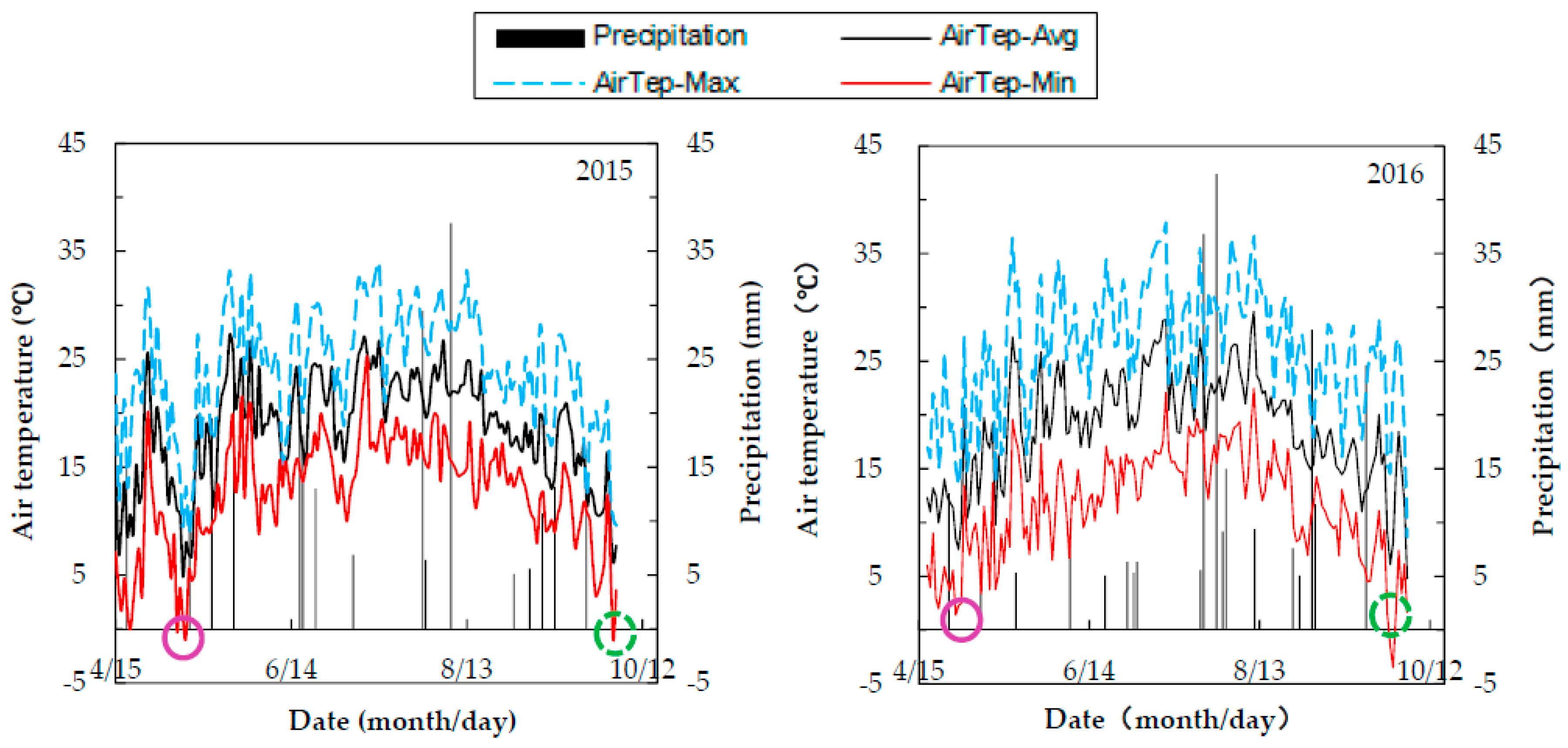
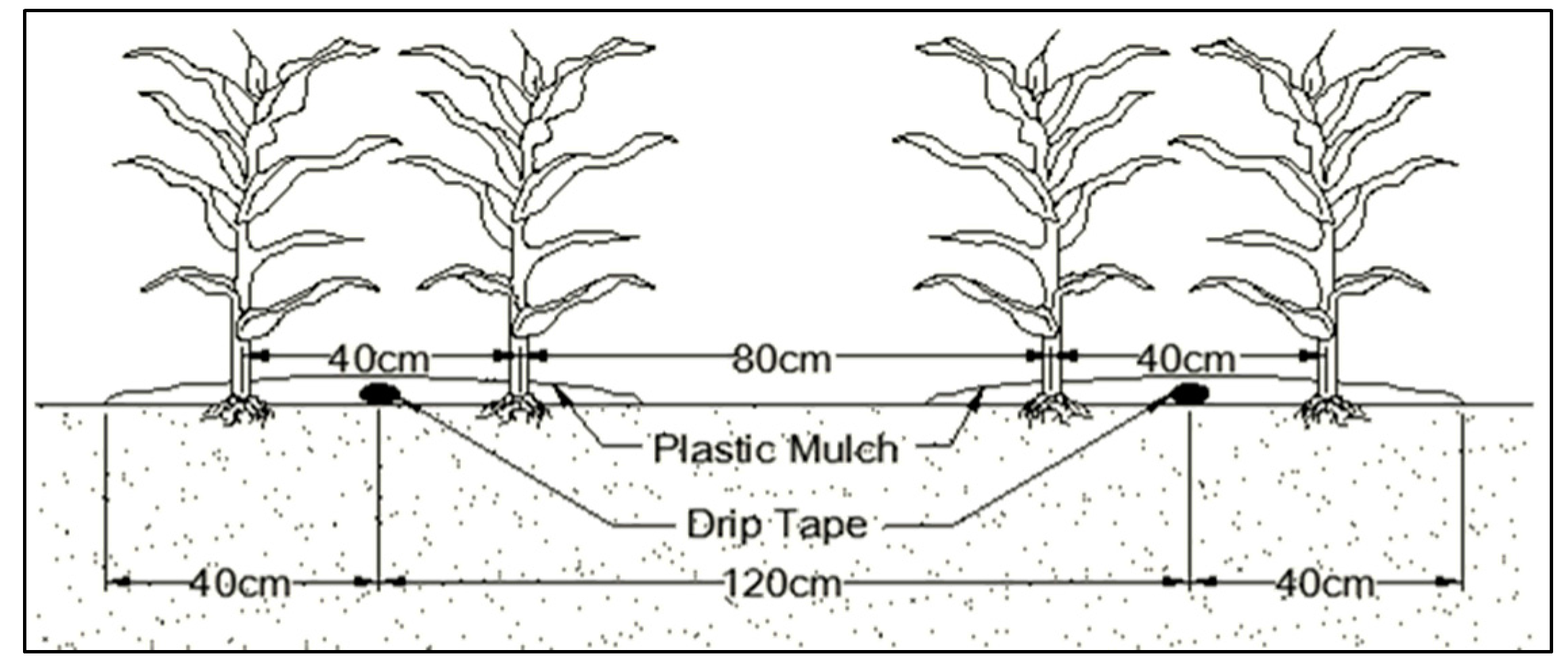
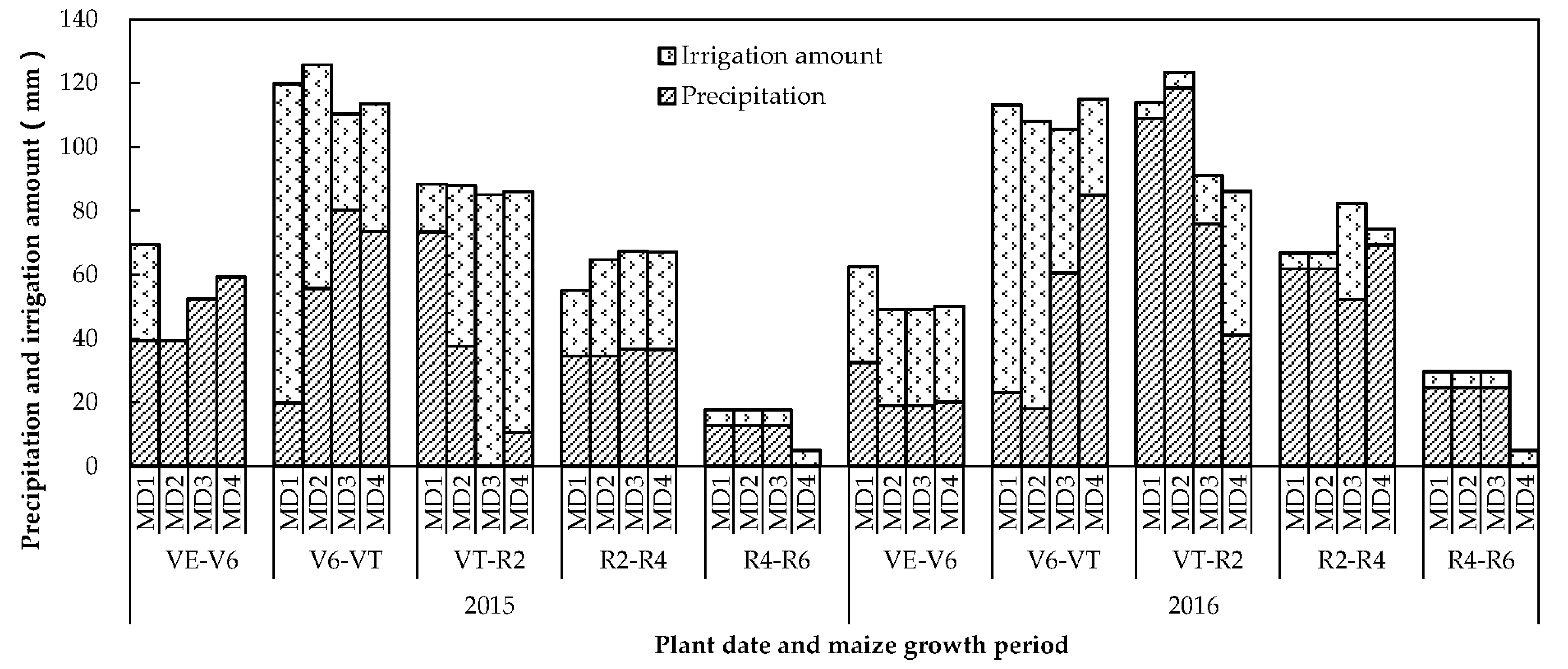
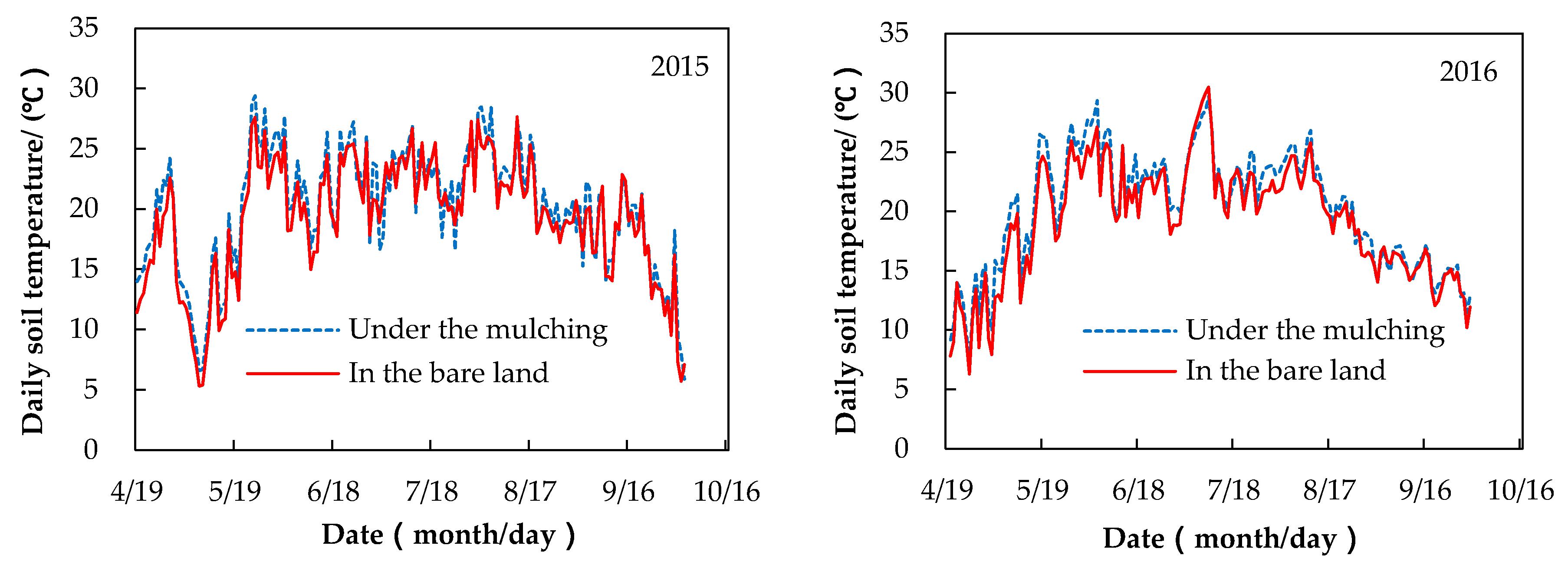


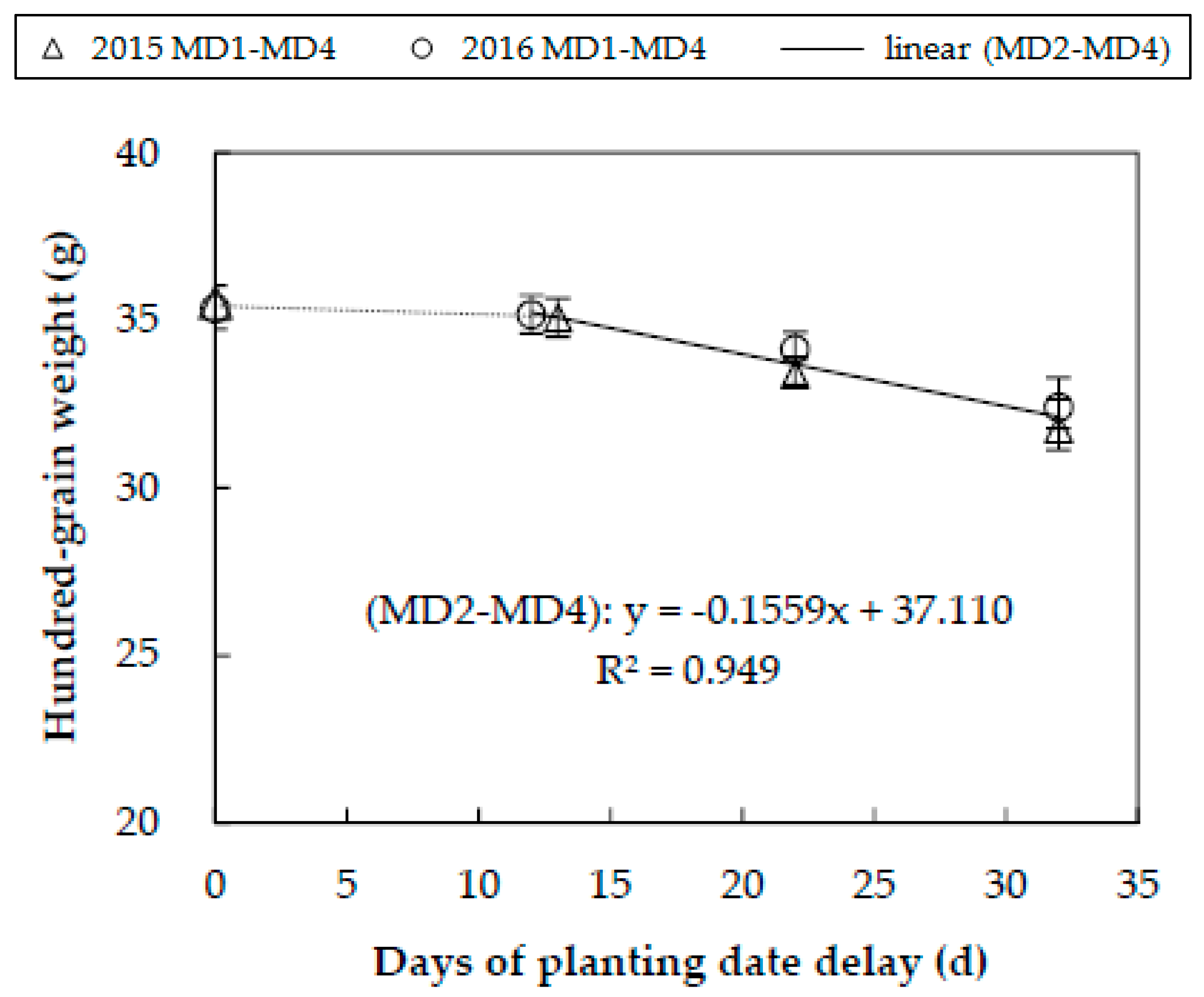
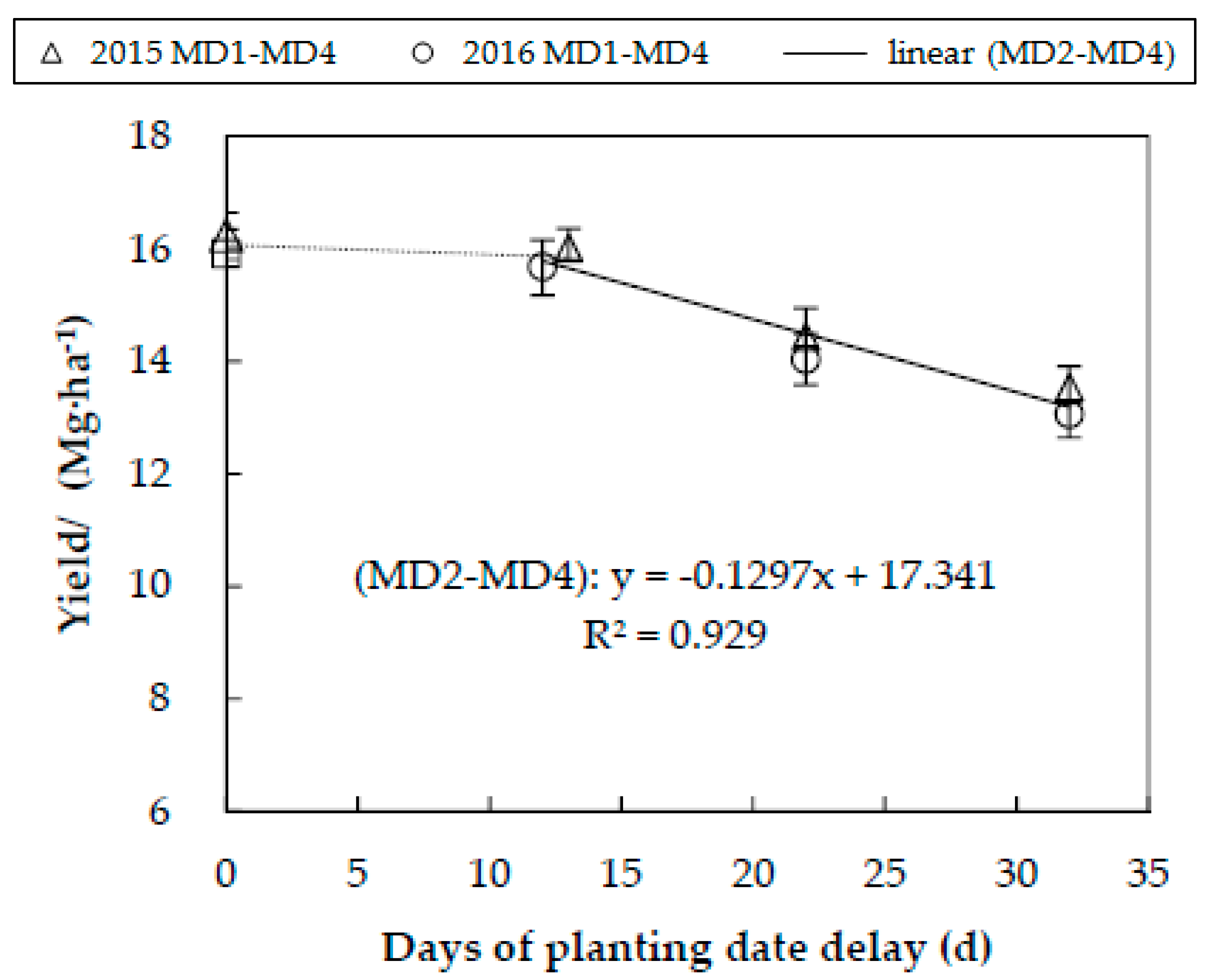
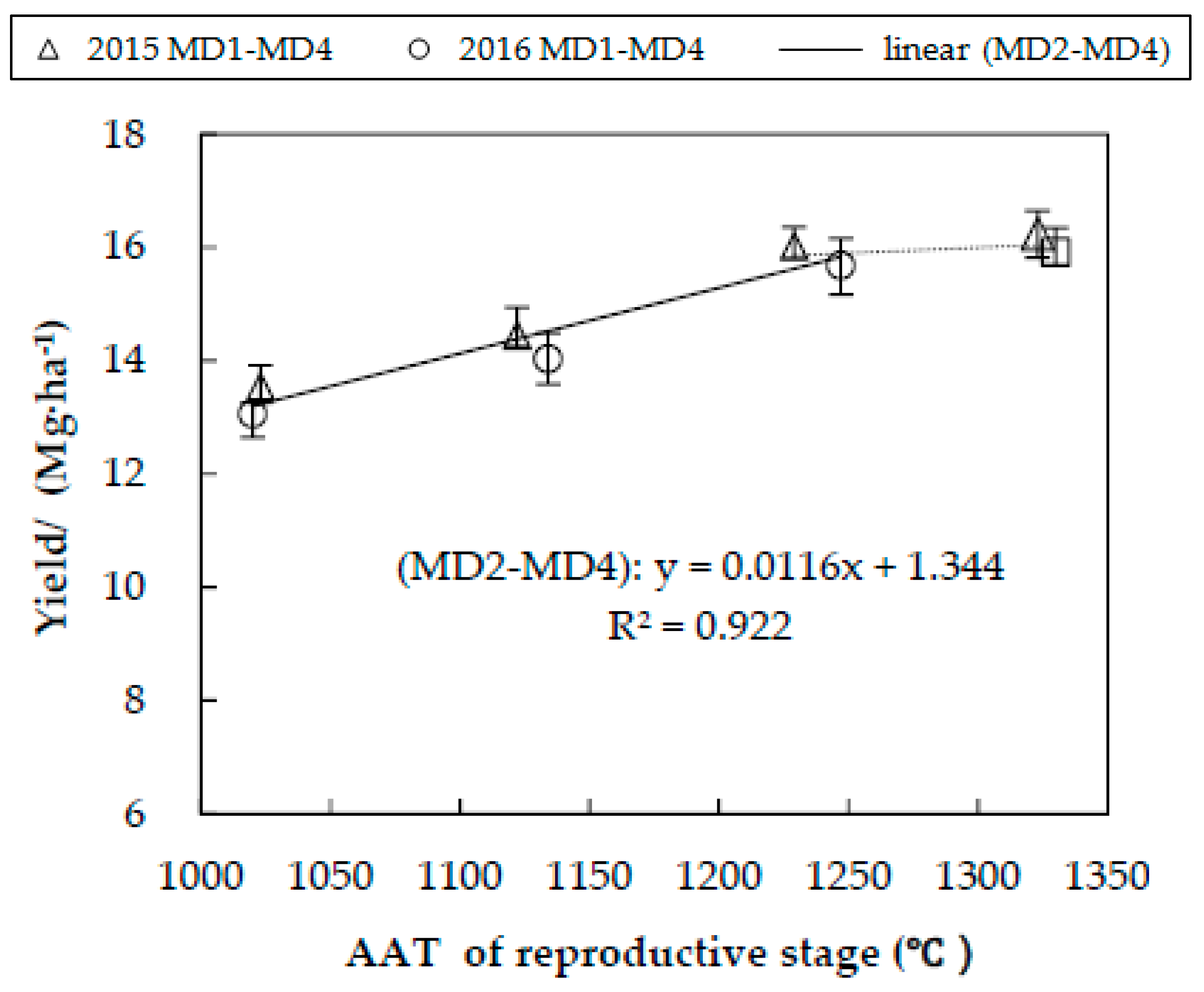
| Fertilizer | Sowing | V6–V12 | VT | R2 | R4 |
|---|---|---|---|---|---|
| N | 20% | 45% | 15% | 15% | 5% |
| P2O5 | 50% | 30% | 20% | -- | -- |
| K2O | 50% | 50% | -- | -- | -- |
| Year | Treatment | Sowing–Harvest | Sowing–VE | VE–VT | VT–Harvest |
|---|---|---|---|---|---|
| 2015 | MD1 | 3050 | 183 | 1544 | 1323 |
| MD2 | 2927 | 210 | 1487 | 1229 | |
| MD3 | 2793 | 235 | 1435 | 1122 | |
| MD4 | 2677 | 207 | 1447 | 1023 | |
| Mean | 2862 | 209 | 1478 | 1174 | |
| 2016 | MD1 | 2993 | 219 | 1443 | 1330 |
| MD2 | 2969 | 214 | 1508 | 1247 | |
| MD3 | 2798 | 214 | 1450 | 1134 | |
| MD4 | 2635 | 186 | 1413 | 1020 | |
| Mean | 2849 | 208 | 1454 | 1183 | |
| Mean | MD1 | 3021 | 201 | 1494 | 1327 |
| MD2 | 2948 | 212 | 1498 | 1238 | |
| MD3 | 2796 | 225 | 1443 | 1128 | |
| MD4 | 2656 | 197 | 1430 | 1022 |
| Year | Treatment | Sowing–Harvest | Sowing–VE | VE–VT | VT–Harvest |
|---|---|---|---|---|---|
| 2015 | MD1 | 155d | 9a | 81b | 65c |
| MD2 | 150c | 17c | 69a | 64c | |
| MD3 | 139b | 11b | 68a | 60b | |
| MD4 | 133a | 10a | 66a | 57a | |
| F-test | 89.9 ** | 42.9 ** | 52.0 ** | 22.7 ** | |
| NM-D2 | 153 | 21 | 67 | 65 | |
| Mean | 146A | 14A | 70A | 62A | |
| 2016 | MD1 | 154d | 18d | 69b | 67c |
| MD2 | 149c | 14c | 69b | 66c | |
| MD3 | 141b | 12b | 67a | 62b | |
| MD4 | 131a | 10a | 64a | 57a | |
| F-test | 200.5 ** | 143.9 ** | 16.3 ** | 45.2 ** | |
| NM-D2 | 152 | 18 | 67 | 67 | |
| Mean | 145A | 14A | 67A | 64A | |
| Mean | MD1 | 155d | 14ab | 75b | 66c |
| MD2 | 150c | 16b | 69a | 65c | |
| MD3 | 140b | 12ab | 67a | 61b | |
| MD4 | 132a | 10a | 65a | 57a | |
| F-test | 200.7 ** | 4.6 * | 8.5 ** | 51.2 ** | |
| NM-D2 | 153 | 20 | 67 | 66 |
| Year | Item | Emergence Rate (%) | Height (cm) | Stem Diameter (cm) | Dry Matter Per Plant | |||
|---|---|---|---|---|---|---|---|---|
| (g·Plant−1) | Proportion (%) | |||||||
| Stem | Leaves | Ear | ||||||
| 2015 | MD1 | 94.5b | 311.5a | 2.6b | 434.9b | 19.9a | 11.9a | 68.2b |
| MD2 | 92.1a | 314.2a | 2.6b | 440.2b | 20.2a | 12.1a | 67.7b | |
| MD3 | 93.5ab | 317.3ab | 2.4ab | 400.0a | 23.0ab | 14.6b | 62.4a | |
| MD4 | 93.9ab | 322.0b | 2.3a | 378.5a | 23.9b | 15.4b | 60.8a | |
| F-test | 6.6 * | 4.2 * | 6.8 * | 11.8 ** | 11.5 ** | 16.7 ** | 18.7 ** | |
| NM-D2 | 86.7 | 316.2 | 2.4 | 412.5 | 22.7 | 14.1 | 63.2 | |
| Mean | 92.1A | 316.2B | 2.5A | 413.2B | 21.9A | 13.6A | 64.5A | |
| 2016 | MD1 | 93.5a | 306.0a | 2.5 b | 426.1b | 19.6a | 12.4a | 68.0c |
| MD2 | 93.0a | 309.0b | 2.5b | 423.7b | 20.0a | 13.1ab | 66.9bc | |
| MD3 | 95.2a | 314.4c | 2.3ab | 376.4a | 21.5a | 14.2bc | 64.3ab | |
| MD4 | 95.6a | 319.3 c | 2.1a | 359.3a | 22.1a | 15.0c | 62.9a | |
| F-test | 3.3 | 6.9 ** | 15.2 ** | 39.4 ** | 1.9 | 6.6 * | 7.3 * | |
| NM-D2 | 88.5 | 311.5 | 2.3 | 384.7 | 21.6 | 13.8 | 64.6 | |
| Mean | 93.2A | 312.0A | 2.3A | 394.0A | 20.9A | 13.7A | 65.3A | |
| Mean | MD1 | 94.0ab | 308.6a | 2.6 | 430.5c | 19.8a | 12.1a | 68.1b |
| MD2 | 92.5a | 311.8a | 2.6 | 432.0c | 20.1a | 12.6a | 67.3b | |
| MD3 | 94.3ab | 315.9ab | 2.4 | 388.2b | 22.2b | 14.4b | 63.4a | |
| MD4 | 94.7b | 320.7b | 2.2 | 368.9a | 23.0b | 15.2b | 61.8a | |
| F-test | 4.4 * | 5.6 ** | 9.6 ** | 27.2 ** | 8.6 ** | 22.3 ** | 21.5 ** | |
| NM-D2 | 87.6 | 313.9 | 2.4 | 398.6 | 22.2 | 14 | 63.9 | |
| Year | Treatment | Bald Tip Length (cm) | Hundred-Grain Weight (g) | Grain Number Per Ear | Grain Moisture Content (%) | Yield (14%) (Mg·ha−1) | Total Dry Matter Accumulation (Mg·ha−1) |
|---|---|---|---|---|---|---|---|
| 2015 | MD1 | 1.6a | 35.5c | 592b | 24.9a | 16.24c | 34.25b |
| MD2 | 1.7a | 35.1bc | 604c | 25.4a | 16.02c | 33.77b | |
| MD3 | 2.2b | 33.4ab | 560ab | 28.1b | 14.45b | 31.15a | |
| MD4 | 2.4b | 31.8a | 548a | 29.6b | 13.55a | 29.60a | |
| F-test | 15.3 ** | 9.6 ** | 10.2 ** | 14.2 ** | 24.9 ** | 10.9 ** | |
| NM-D2 | 2 | 34.7 | 576 | 26 | 14.62 | 31.45 | |
| Mean | 2.0A | 34.1A | 576B | 26.8A | 15.20A | 32.20A | |
| 2016 | MD1 | 1.8a | 35.3b | 591b | 24.8a | 15.91b | 33.18b |
| MD2 | 1.9a | 35.2b | 587b | 25.2a | 15.68b | 32.83b | |
| MD3 | 2.5b | 34.1b | 538a | 28.3b | 14.04a | 29.86a | |
| MD4 | 3.0b | 32.4a | 521a | 28.9b | 13.06a | 28.62a | |
| F-test | 48.1 ** | 6.9 * | 29.6 ** | 14.5 ** | 9.9 ** | 28.5 ** | |
| NM-D2 | 2.4 | 34.3 | 558 | 26.27 | 14.29 | 30.91 | |
| Mean | 2.3B | 34.3A | 559A | 26.7A | 14.53A | 31.04A | |
| Mean | MD1 | 1.7a | 35.4c | 592b | 24.8a | 16.08c | 33.71c |
| MD2 | 1.8a | 35.1c | 595b | 25.3a | 15.85c | 33.30c | |
| MD3 | 2.4b | 33.7b | 549a | 28.2b | 14.24b | 30.50b | |
| MD4 | 2.7c | 32.0a | 535a | 29.3b | 13.30a | 29.11a | |
| F-test | 30.3 ** | 41.8 ** | 21.7 ** | 30.4 ** | 59.9 ** | 26.9 ** | |
| NM-D2 | 2.2 | 34.5 | 567 | 26.1 | 14.46 | 31.18 |
© 2017 by the authors. Licensee MDPI, Basel, Switzerland. This article is an open access article distributed under the terms and conditions of the Creative Commons Attribution (CC BY) license (http://creativecommons.org/licenses/by/4.0/).
Share and Cite
Wang, D.; Li, G.; Mo, Y.; Cai, M.; Bian, X. Effect of Planting Date on Accumulated Temperature and Maize Growth under Mulched Drip Irrigation in a Middle-Latitude Area with Frequent Chilling Injury. Sustainability 2017, 9, 1500. https://doi.org/10.3390/su9091500
Wang D, Li G, Mo Y, Cai M, Bian X. Effect of Planting Date on Accumulated Temperature and Maize Growth under Mulched Drip Irrigation in a Middle-Latitude Area with Frequent Chilling Injury. Sustainability. 2017; 9(9):1500. https://doi.org/10.3390/su9091500
Chicago/Turabian StyleWang, Dan, Guangyong Li, Yan Mo, Mingkun Cai, and Xinyang Bian. 2017. "Effect of Planting Date on Accumulated Temperature and Maize Growth under Mulched Drip Irrigation in a Middle-Latitude Area with Frequent Chilling Injury" Sustainability 9, no. 9: 1500. https://doi.org/10.3390/su9091500




